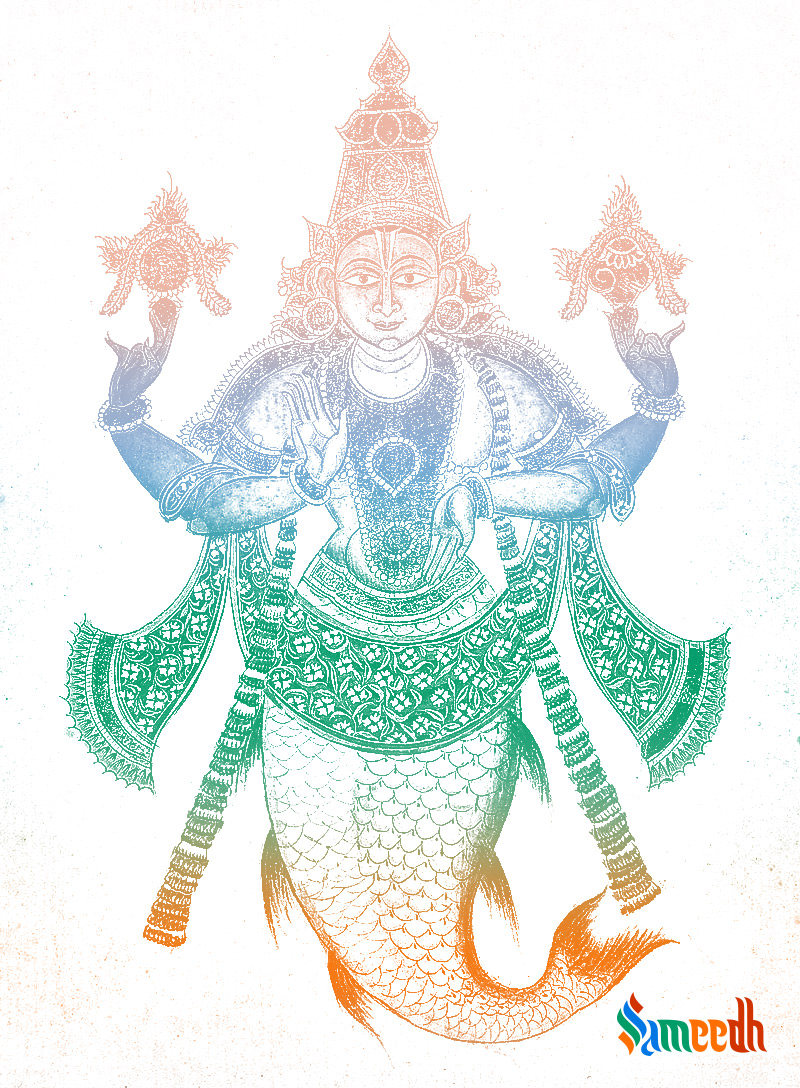Matsya can be represented as an animal or as a human-animal hybrid, with the man representing the upper half and the fish representing the bottom half. The fish (Matsya) and Manu are the main characters in this story.
In Hinduism, an avatar is the embodiment of a deity in human or animal form to counterbalance some particular evil in the universe. Usually referred to as the ten manifestations of Vishnu, an Avatar plays a great role in the history of Indian Mythology. Matsya (fish), Kurma (tortoise), Varaha (boar), Narasimha (half-man, half lion), Vamana (dwarf), Parashurama (Rama with the axe), Rama (hero of the Ramayana epic), Krishna (the holy cowherd), Buddha, and Kalkin (the incarnation yet to come) are the ten manifestations of Vishnu.
The Bhagavad Gita gives one example of this phenomenon when Krishna tells Prince Arjuna:
“Whenever there is a decline of righteousness [Dharma] and rise of unrighteousness then I send forth Myself. For the protection of the good, for the destruction of the wicked, and for the establishment of righteousness, I come into being from age to age.”

The Story Of Matsya
The fish (Matsya) and Manu are the main characters in this story. Manu is a lawmaker and ancestor king who appears in the story. Manu is brought water for his ablutions one day. A small fish swims through the water. The fish expresses its dread of being swallowed by a larger fish and requests Manu’s help in protecting it. The fish pledges to save Manu from an impending flood in exchange. The request is accepted by Manu. He places the fish in a pot of water and allows it to grow. Then he digs a ditch, fills it with water, and moves it to a location where it can grow freely. Manu releases the fish into the ocean once it has grown to a size where it is no longer in danger.
The fish thanks him, informs him of the great flood’s timings, and requests that Manu construct a ship by that day, one that he can tie to its horn. Manu brings his boat to the fish on the predicted day. The terrible floodwaters have arrived. Manu secures the horn to the boat. The fish carries Manu and the boat to the northern alpine highlands (interpreted as the Himalayas). Manu, the lone survivor, then re-establishes his life via penance and yajna (sacrifices). The goddess Ida arrives as a result of the sacrifice, and the two of them join forces to create the Manu race of people.
The small fish is a reference to the Indian “rule of the fishes,” which is similar to the “law of the jungle.” The small and weak would be consumed by the great and powerful, and it requires the legislator and king Manu’s dharmic protection in order to reach its full potential and subsequently be able to help. Manu gives safety, the small fish grows into a large fish, and eventually saves all of existence.
Matsya can be represented as an animal or as a human-animal hybrid, with the man representing the upper half and the fish representing the bottom half. Matsya is usually depicted with four hands: one holding the conch shell, one holding the discus (chakra), one granting a boon (varada mudra), and one providing protection (abhaya mudra). The man-half should be depicted wearing all of the decorations connected with Vishnu, according to sculpting canons.
